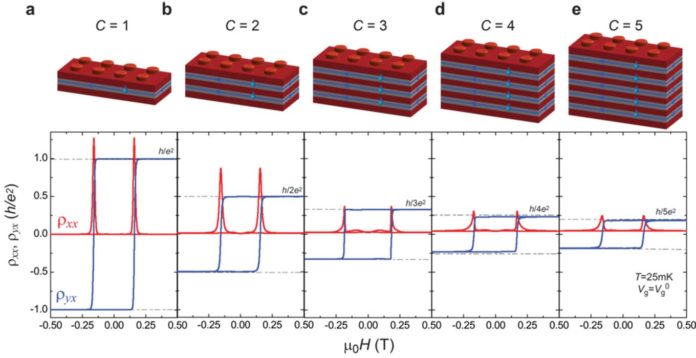The quantum anomalous Hall effect is defined as a quantized Hall effect realized in a system without an external magnetic field. In this effect, an electrical current does not lose energy as it flows along the material’s edges — over a broader range of conditions.
Scientists from Penn State recently demonstrates the anomalous quantum Hall (QAH) effect in energy-efficient electronic devices. They experimentally realized the QAH effect in a multilayered insulator that creates a multilane highway for the electrons transmission that increases information transfer speed and efficiency without energy loss.
Cui-Zu Chang, assistant professor of physics at Penn State, said, “A large number of electrons in metals can sometimes result in a traffic jam because electrons moving in different directions get scattered and repel each other.”
“In QAH insulators, electron flow is constrained to the edges, and electrons on one edge can only go in one direction, and those on the other edge can only go the opposite direction, like splitting a road into a two-lane highway.”
Scientists used a topological insulator to fabricate the QAH insulators. They made topological insulators magnetic by using a process called diluted magnetic doping.
Using a molecular beam epitaxy technique, scientists fabricated multilayered topological insulators, carefully controlling where magnetic doping occurred.
Later, scientists stacked alternating layers of magnetic and non-magnetic topological insulators. They then realized the QAH state with Chern numbers up to 5, essentially constructing five parallel highways for electrons on each side of the material for a total of 10 lanes.
Chao-Xing Liu, associate professor of physics at Penn State and co-author, said, “We do see some dissipation of current at connection points between QAH insulators and metallic electrodes, which occurs in the form of heat. You can think of it as the on and off-ramps of a busy highway, where the narrow merge lane into local traffic slows you down. By building more parallel highways, more merge lanes can connect the highways to local traffic, so that the overall speed of the whole traffic system can be greatly improved.”
Scientists found that by increasing the thickness of the QAH insulator layers or manipulating the concentration of magnetic doping in the QAH layer, they could tune the Chern number of the sample.
Chang said, “In other words, we could change the number of lanes in the highway with an external knob. Even at high Chern numbers, the QAH insulators had no dissipation along the edge channels. This provides a proof-of-concept for devices that take advantage of this dissipationless edge current.”
Scientists, in this study, carefully fabricated separate QAH insulators with different Chern numbers.
Nitin Samarth, Downsbrough Department Head of Physics at Penn State, said, “This is an impressive scientific advance in the field of quantum materials. We are fortunate to have recruited talented scientists such as Dr. Chang and Dr. Liu to our faculty. Penn State continues to make significant investments in the sophisticated equipment and laboratory facilities essential for supporting junior faculty at the frontiers of quantum science and technology. This research is an excellent example of payoff.”
Journal Reference:
- Zhao, YF., Zhang, R., Mei, R. et al. Tuning the Chern number in quantum anomalous Hall insulators. Nature 588, 419–423 (2020). DOI: 10.1038/s41586-020-3020-3
